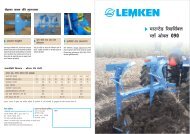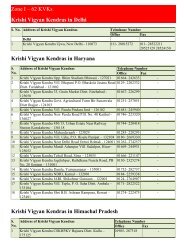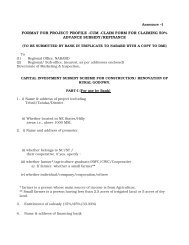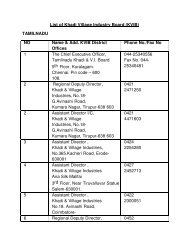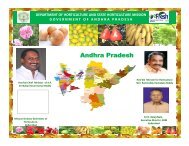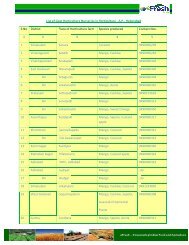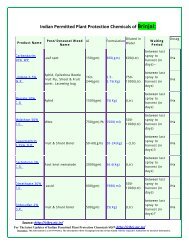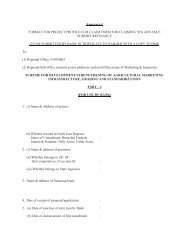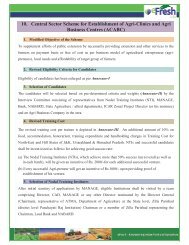SEED PRODUCTION OF ONION (Allium cepa L.) - Efresh India
SEED PRODUCTION OF ONION (Allium cepa L.) - Efresh India
SEED PRODUCTION OF ONION (Allium cepa L.) - Efresh India
Create successful ePaper yourself
Turn your PDF publications into a flip-book with our unique Google optimized e-Paper software.
Seed Production of Onion(Alliun <strong>cepa</strong> L.)<br />
<strong>SEED</strong> <strong>PRODUCTION</strong> <strong>OF</strong> <strong>ONION</strong> (<strong>Allium</strong> <strong>cepa</strong> L.)<br />
Agricultural production and productivity are influence by several factors. Of them, seed is<br />
the vital input which significantly helps in enhancing the productivity of crops. The seed<br />
production of onion is very difficult phenomena as it is produced in two phases. In first phase, the<br />
bulb production is required, while under second phase the seed production takes place from the<br />
bulbs.<br />
Method of Seed Production<br />
Seed- to- seed method<br />
Seed sowing in rows Healthy onion nursery Seedling Transplanting<br />
Bulb storage<br />
Transplanted Field<br />
www.efreshindia.com Page 1 of 19
Seed Production of Onion(Alliun <strong>cepa</strong> L.)<br />
Bulb harvesting<br />
Onion bulb production<br />
The bulb is as such left and allows bolting and flowering in the same field where the transplanting<br />
was earlier done. The seeds are sown in the nursery from June to August and transplanting is done<br />
from August to October. Bolting starts in January-February and seeds are ready for harvesting by<br />
mid May. Seeds of onion varieties like Agrifound Dark Red, Baswant-780, Arka Kalyan and other<br />
kharif varieties are produced this method.<br />
Merits<br />
• Low-cost method of seed production<br />
• Early maturity<br />
• No need to store the bulbs.<br />
Demerits<br />
• It is not possible to select the true type<br />
bulbs and thus high quality seed<br />
production is not possible.<br />
• Seed yield is low.<br />
Bulb- to -seed method<br />
Bulb Transplanting<br />
Growing<br />
www.efreshindia.com Page 2 of 19
Seed Production of Onion(Alliun <strong>cepa</strong> L.)<br />
Distribution<br />
Flowering stage<br />
Packaging<br />
Pollination<br />
Final seed cleaning<br />
Harvest ready<br />
Pre-cleaning<br />
Drying of umbels<br />
www.efreshindia.com Page 3 of 19
Seed Production of Onion(Alliun <strong>cepa</strong> L.)<br />
In this method the bulbs are lifted from field and after proper selection they are replanted in<br />
the field. There are two methods used for seed production.<br />
Annual method: The seeds are sown in June – July, transplanting in August – September. Bulbs<br />
are ready by November–December. The bulbs are lifted and cured. Selected bulbs are replanted<br />
in another field after 10-15 days that is from mid-November to mid-December. The bolting in this<br />
case starts in January-February and seeds are ready by May. Seeds of onion Agrifound Dark<br />
Red, N-53, Baswant-780, Arka Kalyan and Phule Safed are produced by this method.<br />
.<br />
Biennial method: The seed of onion is sown in October-November and seedlings are<br />
transplanted in December-January. The bulbs are ready by April end to mid May. The selected<br />
bulbs are stored up to mid-October and planted in well-prepared fields. Since this takes about one<br />
and half year, it is called as biennial method. The seeds of Agrifound Light Red, NHRDF Red,<br />
Pusa Red, N-2-4-1, and other rabi onion varieties are produced by this method.<br />
Merits<br />
• Selection of true-to-type bulbs is possible<br />
and quality seeds are produced by this<br />
method.<br />
• Higher yield is obtained.<br />
Demerits<br />
• It takes more time<br />
• Losses of onion bulbs during storage<br />
• Cost of seed production is more<br />
The bulbs to seed methods is better method and gives pure and high quality seed.<br />
Storage of mother bulbs<br />
In annual method, selected bulbs are planted in well-prepared beds after curing for 10-15<br />
days, but under biennial methods bulbs are stored from June to October in well-ventilated godown<br />
for further use for planting during October-November.<br />
Manglore tiled storage<br />
Improved ventilated<br />
storage strucrure<br />
www.efreshindia.com Page 4 of 19
Seed Production of Onion(Alliun <strong>cepa</strong> L.)<br />
Cultivation Practices in brief<br />
Climate<br />
Temperatures of 4.5-14 o C is favourable for seed stalk formation. Longer these prevails more<br />
flower stems will each plant produce and more flower will be there in each umbel. The best seed<br />
producing areas are those where there is low humidity. Long rainy periods or heavy dew and fog,<br />
favour the development of Stemphylium blight and Purple blotch. During flowering of onions, clear<br />
and bright days are necessary to ensure activity insects for pollination. It is equally important to<br />
have hot and dry weather during the harvesting, curing and threshing of seeds.<br />
Soil<br />
Onion seed crop can be grown on a wide range of soils but very light sandy soils are avoided.<br />
Light heavier soils should be preferred because they are cooler, have a high water retaining<br />
capacity and are more productive.<br />
Selection of Bulbs<br />
Medium sized bulbs (4.5-6.5 cm) especially single centered should be selected for planting to get<br />
maximum yield. Though the big sized bulbs give more number of sprouts and thus give higher<br />
seed yield but it is not economical as the cost increases. Medium sized bulbs are better and<br />
economical for seed production.<br />
Land Preparation<br />
The field is ploughed by tractor-drawn implements or deshi plough to a fine tilth by giving four<br />
ploughings with a sufficient interval between two ploughings. The planking should be done for<br />
proper levelling. The field is then divided into beds and channels. The water logging affects<br />
production and quality of seeds. The beds for planting of bulbs under drip irrigation system should<br />
be raised as per system the fitted in the field.<br />
Planting Time of bulbs<br />
www.efreshindia.com Page 5 of 19
Seed Production of Onion(Alliun <strong>cepa</strong> L.)<br />
Last week of October to first fortnight of November is best time for planting of bulbs in rabi onion<br />
varieties. Kharif onion bulbs since are available during November end or early December, they<br />
should be planted by 15th December from the same crop and this way seed production can be<br />
taken within a year. The cutting of one third top of bulb and dipping for 5 minutes with 1%<br />
carbendazim + 1% potassium nitrate or 1% potassium orthophosphate increases seed yield in<br />
kharif onion bulbs.<br />
Spacing<br />
Selected bulbs of 4.5 cm-6.5 cm size are planted in well-prepared field at the distance of 45 cm x<br />
30 cm in normal loam to clay loam soil. If the spacing is kept closer because of less ventilation,<br />
drying of field is slow after irrigation, thus heavy dew and rains favour the disease. In sandy soils,<br />
spacing may, however, be reduced to even 30 cm x 30 cm. The depth is kept 7.5 cm. Irrigation is<br />
given immediately after transplanting. The spacing can be reduced if seed production is being<br />
taken under drip system of irrigation. About 25-30 quintals bulbs are enough to plant one hectare<br />
area.<br />
Manures and fertilizers:<br />
About 20-25 tonnes of FYM/ha is required to use at the time of field preparation. The requirement<br />
of nutrients depends on soil type, region of growing, varieties and removal of major nutrients.<br />
About 80-100 kg of nitrogen, 60 kg of P 2 0 5 and 50 kg of K 2 0/ha is recommended in general. If soil<br />
is low in nitrogen 120 kg N/ha should be applied. Whole quantity of phosphorus, potash and half<br />
of nitrogen should be mixed in soil before planting. The rest half doses of nitrogen should be<br />
given as topdressing in two equal split doses, first dose should be applied 30 days after planting<br />
whereas second 45 days after planting.<br />
Irrigation and aftercare:<br />
Irrigation is given at 7-10 days interval depending upon the types of soils and seasons. Earthing is<br />
done after two months of transplanting to avoid lodging. Weeding and hoeing are done as per the<br />
requirement. Specific precautions are taken in irrigating the crop more frequently during flowering<br />
and seed setting. The use of drip irrigation and mulching with wheat or paddy straw recommended<br />
for effective management and getting higher seed yield. Use of paddy straws as mulch in seed<br />
crop with drip irrigation increases seed yield by 42% in onion variety Agrifound Dark Red with a<br />
higher net return.<br />
Drip Irrigation<br />
Sprinkler Irrigation<br />
www.efreshindia.com Page 6 of 19
Seed Production of Onion(Alliun <strong>cepa</strong> L.)<br />
Weed management:<br />
Weeds are to be kept down to get good yield. Use of stomp @ 3.5 litre / ha before bulb planting<br />
and one hand weeding at 45 days is required.<br />
Isolation<br />
Onion is highly cross pollinated crop. During seed production, onion varieties require isolation.<br />
The required isolation distances are given below:<br />
Contaminant<br />
Minimum isolation distance (m)<br />
Field of other variety<br />
Field of the same variety not conforming to<br />
varietal purity requirement for certification<br />
For mother bulb production<br />
Foundation seed<br />
1,000<br />
1,000<br />
Certified seed<br />
500<br />
500<br />
5<br />
5<br />
For breeder seed production isolation distance should be 1,500 m.<br />
Important Diseases and Insect Pests:<br />
Diseases:<br />
Purple blotch<br />
The disease is caused by Alternaria porri (Ellis) Cif. The typical eye-shaped symptoms<br />
appear on leaves and flower stalks as small, sunken, whitish flecks with purple colored centre.<br />
Further large purple area develops forming dead patches. The disease appears at the<br />
temperature of 28-30° C and RH 90-100%. The fungicides such as Mancozeb (Dithane M-45) @<br />
0.25% or Chlorothalonil (Kavach) @ 0.2% or Iprodion (Rovral) @ 0.25% should be sprayed at<br />
fortnightly interval just after appearance of disease. The sticker, triton/indtron/sandovit should be<br />
mixed in spray solution @ 0.06%.<br />
www.efreshindia.com Page 7 of 19
Seed Production of Onion(Alliun <strong>cepa</strong> L.)<br />
Stemphylium blight:<br />
The disease is caused by Stemphylium vesicarium (Wallr.) Simmons. The symptoms occur on<br />
leaves and seed stalk from late-March to early-April. Infection appears as small yellow to pale<br />
orange spots or streaks in middle of leaves on inner side and flower stalks. The disease is more<br />
severe, after infestation of onion thrips. Thus both fungicides and insecticides sprays are required.<br />
Spraying of fungicide such as Mancozeb @ 0.25% or chlorothalonil (Kavach) @ 0.2 % along with<br />
insecticides deltamethrin (Decis) @ 0.10% and sticker triton at fortnightly interval should be<br />
followed just after appearance of the disease.<br />
Iris yellow spot virus:<br />
The disease is caused by Tomato spotted wilt virus (tospo virus group). The typical symptoms are<br />
yellowish, straw coloured, eyelike or diamond-shaped lesions on flower stalks. Some lesions on<br />
flower stalk have concentric rings altering with green and yellow colour pigment. The number of<br />
spots varies from one to several in a seed stalk at a time as well as spots appears on upper,<br />
middle and lower portion of stalk. The curling and banding of seed stalk are observed from the<br />
point of infection where necrotic spots develop. In severe condition, spots may griddle the scape,<br />
drying the umbel and reducing the seed yield and quality.<br />
www.efreshindia.com Page 8 of 19
Seed Production of Onion(Alliun <strong>cepa</strong> L.)<br />
Disease Transmission: Thrips (Thrips tabaci) is the only known vector for transmission of this<br />
disease.<br />
Control of the vector (thrips) is done by,<br />
spraying with Deltamethrin 2.8 % EC (Decis) @ 0.1 % or spinosad 2.5 % SC (Success) @ 0.1 %<br />
or Fipronil 5 % SC (Reagent) @ 0.15 % at 15 days intervals.<br />
Insect Pests:<br />
Onion Thrips<br />
Onion thrips, Thrips tabaci Lindeman (Thysanoptera: Thripidae) is a regular and potential pest of<br />
onion in tropical areas.<br />
Thrips attack onion at all the stages of crop growth. Both nymphs and adults cause direct damage<br />
by puncturing the epidermis of the leaves and seed stalk and suck out sap with modified piercing<br />
and sucking mouthparts. Sometimes plants show twisting and curling. And the flowers become<br />
discoloured, deformed and dry. Good cultural practices can help reduce onion thrips infestation.<br />
Volunteer onion plants are an important source of infestation for thrips. So removal of<br />
unharvested plant parts from owns the field can reduced the thrips population. Weed are the<br />
alternate host for thrips, weed free plots/sanitation can also reduced the thrips population.<br />
Predators, parasitoids and insect pathogens comprise the biological agents for suppressing pest<br />
population. Many such natural enemies are successfully employed in pest management<br />
programme in various vegetable ecosystems. In <strong>India</strong> and abroad, many biological agents like<br />
onion Orius albidipennis, Aeolothrips collaris, Laius externotatus, Scymnus nubilus are reported<br />
attacking T. tabaci in onion fields. Spray formulations of Beauveria bassiana are recommended to<br />
control thrips. Insecticides likes Deltamethrin 2.8 % EC @ 0.095%, Lambda cyhatothrin 5<br />
EC @ 0.05%, Fipronil oscs @ 0.1%, spinosad 45% EC @ 0.1% EC and profenophos 50EC @<br />
0.1% are found effective to suppress thrips population. The insecticides should reach the base of<br />
the leaves where the majority of thrips are located. Addition of sticker @ 0.06% is useful for<br />
retention and spread of spray fluid on erect leaves.<br />
www.efreshindia.com Page 9 of 19
Seed Production of Onion(Alliun <strong>cepa</strong> L.)<br />
Gram Caterpillar:<br />
Gram caterpillar (Helicoverpa armigera Hubner) is a polyphagous pest, occurring sporadically on<br />
onion grown for seed crop. Larvae feed inside the stem and move upwards to reach the base of<br />
the umbel at early stages of flowering. Subsequently, it invades the umbel and feeds on seeds. As<br />
a result, complete drying of flowers and complete loss of seed occurs. Spraying of Heliothis NPV<br />
@ 250 LE/ha, and Endosulphan @ 0.3% is effective in control of Helicoverpa armigera.<br />
Roguing<br />
Diseased and off-type plants are rogued out before flowering for quality seed production.<br />
Mode of Pollination<br />
Onion is highly cross pollinated crop and bees are main pollinating agents. So, it is necessary to<br />
have good number of bees for proper pollination and seed setting.<br />
Following points should be taken care for improving the pollination.<br />
• Bee colonies are kept in field<br />
• Irrigation should be given more frequently at the time of flowering and seed setting<br />
• Only safer insecticides for control of insects should be sprayed during flowering. The spray<br />
should be done in evening or early morning, when there are no bees.<br />
www.efreshindia.com Page 10 of 19
Seed Production of Onion(Alliun <strong>cepa</strong> L.)<br />
• In case of more wind, sometimes bees do not sit on flowers. The plant windbreaks all around<br />
the field should be grown.<br />
Harvesting and Curing<br />
Optimum stage of harvest<br />
All seed heads do not mature simultaneously, therefore, harvesting is done in instalments. When<br />
seed inside capsules become black and 20-25% black seeds are exposed the umbels should be<br />
cut with 10-15 cm stem attached. The umbels are spread on ground or canvas to avoid attack of<br />
mould for drying.<br />
Threshing, Cleaning and Seed Extraction<br />
After proper drying, the umbels are threshed either by rubbing with hands manually or by<br />
movement of bullocks or tractor on seed umbels.<br />
• Seeds are threshed when capsules are brittle and break readily. Threshing is done by flairing<br />
method. Cleaning is done by air screen machine by using 1 / l4 x 1 / 2 as grading screen.<br />
• Seed is cleaned by using hand winnowers and fans.<br />
• Use of seed cleaners, graders and gravity separator with appropriate sequence is useful for<br />
getting cleaning and graded seeds.<br />
• Dipping of seeds in water for cleaning, in no case is done for more than 2-3 minutes as<br />
otherwise the germination is affected adversely. Upgrading is further done on gravity<br />
separator.<br />
Drying, Packing and Storage<br />
For safe storage, seeds are dried to a level of about 6% moisture and then packed in aluminium<br />
foil or tins which are moisture proof. Seeds are then stored in air-conditioned and dehumidified<br />
stores having temperature of 16-20° C and relative humidity of 30-40%. In hot and humid climate<br />
the viability of onion seed is lost within a year. The onion seed if dried to 6.0% moisture level and<br />
stored in sealed containers, the life of seeds may be prolonged to 3-4 years without loss in<br />
germination.<br />
www.efreshindia.com Page 11 of 19
Seed Production of Onion(Alliun <strong>cepa</strong> L.)<br />
Seed Yield<br />
The normal seed yield is 6-8 q/ha. Sometimes when weather conditions are favourable 12-15<br />
quintals seed yield can be obtained from one hectare.<br />
Seed Certification<br />
The different steps/ requirements of certification for onion seed production are mentioned<br />
as under:<br />
Minimum seed certification standard<br />
Application and amplification of general seed certification standards<br />
The general seed certification standards are basic and together with following specific standards<br />
constitute for certification of onion seed.<br />
Land requirement<br />
The land to be used for seed production of onion shall be free from volunteer plants.<br />
Field inspection<br />
A. Mother bulb production stage<br />
• First inspection shall be made after transplanting of seedlings in order to determine isolation,<br />
volunteer plants, off-types including bolters and other relevant factors.<br />
• The second inspection shall be made after the bulbs have been lifted to verify the true<br />
characteristics of bulbs.<br />
B. Seed production stage<br />
• The first inspection should be made before flowering in order to determine isolation, off types<br />
including bolters and relevant factors.<br />
• The second and third inspection shall be made during flowering to check isolation, off types<br />
and other relevant factors.<br />
• The forth inspection shall be made at maturity to verify the true nature of the plant and other<br />
relevant factors.<br />
Field standards<br />
(A) General requirements<br />
Isolation<br />
Contaminant<br />
Isolation distance (m)<br />
Mother bulbs production<br />
Seed production<br />
Foundation<br />
Seed<br />
Certified<br />
Seed<br />
Foundation<br />
Seed<br />
Certified<br />
Seed<br />
Field of other variety<br />
Field of the same variety not<br />
conforming to varietal purity<br />
requirement for certification<br />
5<br />
5<br />
5<br />
5<br />
1,000<br />
1,000<br />
500<br />
500<br />
www.efreshindia.com Page 12 of 19
Seed Production of Onion(Alliun <strong>cepa</strong> L.)<br />
(B) Specific requirements<br />
Factor<br />
Maximum permitted limit<br />
* Bulbs not confirming to the<br />
varietal characteristics<br />
**Off-types<br />
Foundation<br />
0.10% (by number)<br />
0.10%<br />
Certified<br />
0.20% ( by number)<br />
0.20%<br />
* Maximum permitted at second inspection at mother bulb production stage<br />
** Maximum permitted at and after flowering at seed production stage<br />
v. Seed standard<br />
Factor<br />
Maximum permitted limit<br />
Pure seed (minimum)<br />
Genetic purity (minimum)<br />
Insert matter (maximum)<br />
Other crop seed (maximum)<br />
Weed seeds (maximum)<br />
Germination (minimum)<br />
Moisture (maximum)<br />
For vapour-proof containers (maximum)<br />
Foundation Seed<br />
98.0%<br />
98.0%<br />
2.0%<br />
5.0/kg<br />
5.0/kg<br />
70.0%<br />
8.0%<br />
6.0%<br />
Certified Seed<br />
98.0%<br />
98.0%<br />
2.0%<br />
10.0/kg<br />
10.0/kg<br />
70.0%<br />
8.0%<br />
6.0%<br />
Do’s and Dont’s:<br />
www.efreshindia.com Page 13 of 19
Seed Production of Onion(Alliun <strong>cepa</strong> L.)<br />
Do’s<br />
Dont’s<br />
1. Mother bulb production should be done<br />
by adopting improved methods of<br />
cultivation.<br />
2. The variety and bulbs selected for seed<br />
production should be of notified variety<br />
and bulbs should bear the specified<br />
characteristics like shape, colour, size<br />
etc.<br />
3. Avoid cultivating seed crop in highly<br />
alkaline and saline soils.<br />
4. Always adopt bulb to seed method of<br />
seed production technology.<br />
5. Avoid, planting seed crop in high humid,<br />
and rainfall conditions.<br />
6. Always select medium sized bulbs for<br />
seed production.<br />
7. Field should be ploughed to a fine filth for<br />
better crop growth.<br />
8. Bulbs for seed production should be<br />
planted in between last week of October<br />
to first fortnight of November for rabi<br />
onion varieties.<br />
9. For Kharif onion varieties, ideal time of<br />
planting is last week of November to 15 th<br />
December.<br />
10. Dip the 1/3 rd top cutted bulbs for 5<br />
minutes in the solution of 0.1%<br />
carbendazim + 1% potassium nitrate or<br />
1% potassium orthophosphate before<br />
planting for fast sprouting.<br />
11. Spacing of 45 cm x 30 cm is ideal for<br />
better crop growth and seed yield.<br />
12. Maintain recommended isolation<br />
distance for avoiding admixture in the<br />
variety.<br />
13. Roughing of off-type plants should be<br />
done regularly.<br />
14. Keep honey bee colonies in field for<br />
better pollination and more seed yield.<br />
15. Harvest umbels, only when 20-25%<br />
seeds become black in the capsules and<br />
are exposed.<br />
1. Don’t adopt seed-to-seed method.<br />
2. Don’t take seed production in the area<br />
where rainy periods are long or heavy<br />
dew and fog prevails.<br />
3. Avoid very light or sandy soil.<br />
4. Don’t select the bulbs below 4.5 cm<br />
diameter and above 5.5 cm, for planting.<br />
5. Never plant bulbs for seed production<br />
before November and after December.<br />
6. Don’t plant the bulbs in close spacing, as<br />
due to dense plants, the soil moisture will<br />
not evaporate, and leads to infection of<br />
disease.<br />
7. Don’t forget to maintain required isolation<br />
distance.<br />
8. After flowering, never spray insecticides<br />
for thrips control except endosulphon, as<br />
other insecticides may repell honey bees,<br />
and pollination will be affected.<br />
9. Never harvest immature seed umbells.<br />
Such umbells leads to low germination.<br />
10. Never store seed having moisture more<br />
than 6%.<br />
11. Don’t use diseased and insect affected<br />
bulbs for planting.<br />
12. Don’t select discolour, double, bruised<br />
bulbs for planting.<br />
13. Don’t purchase the seed from market<br />
unless, source of seed is known, and<br />
germination, moisture and purity is given<br />
on the seed packet.<br />
www.efreshindia.com Page 14 of 19
Seed Production of Onion(Alliun <strong>cepa</strong> L.)<br />
16. Thresh the seed only when the capsules<br />
are brittle and break readily.<br />
17. Seeds should be dried to a level of about<br />
6% moisture.<br />
18. Seeds should be stored at dry and less<br />
humid place, so as to avoid loss of vigour<br />
and vitality.<br />
19. Treat seed with thiram or captan 2 gm /<br />
kg seed before storage or before sowing<br />
in the field.<br />
20. For marketing and transportation pack<br />
the treated seed in cloth bags, and put<br />
polythene lining before packing in gunny<br />
bags.<br />
21. Before sowing the seed in the field,<br />
check germination.<br />
22. Before purchasing seed from market,<br />
see the year of production and<br />
germination report.<br />
Onion Seed Certification Proceduresd<br />
Phases of Seed Certification<br />
Certification shall be completed in six broad phases listed under<br />
• Receipt and scrutiny of application.<br />
• Verification of seed / bulb source, class and other requirements of the seed / bulb used for<br />
raising the seed crop.<br />
• Field inspections to verify conformity of the standing crop to the prescribed field standards.<br />
• Supervision of post-harvest stages including processing and packaging;<br />
• Seed sampling and analysis, including genetic purity test and / or seed health test, if any, in<br />
order to verify conformity to the prescribed standards and<br />
• Grant of certificate and certification tags, bagging and sealing.<br />
Seed Certification Procedures<br />
www.efreshindia.com Page 15 of 19
Seed Production of Onion(Alliun <strong>cepa</strong> L.)<br />
All the seed / bulb material to be used for seed production programme is subject to verification by<br />
the Agency. The seed producer should submit to the Agency relevant evidence such as<br />
certification tags, seals, labels, seed containers, purchase records, sales records etc, as may be<br />
demanded by the Agency during scrutiny of the application and/or during the first inspection of the<br />
seed crop in order to confirm that the seed / bulb used for raising the crop has been obtained from<br />
a source approved by the Agency and conforms to the class of seed / bulb required for seed<br />
production. A source-verification register containing relevant information as prescribed should be<br />
maintained by the seed producer for verification by Agency staff. After source verification<br />
application for certification should be submitted in the prescribed FORM-1 in triplicate to the<br />
concerned Seed Certification Office. FORM-1 is available with the divisional and zonal offices of<br />
the Agency. FORM-1 should be submitted within 30 days from the date of sowing or 15 days from<br />
the date of planting as the case may be. The relevant seed certification charges such as<br />
Registration fee, inspection fee grow out test charges (wherever necessary), seed testing<br />
charges, etc. should be remitted along with FORM-1. Separate FORM-1 should be submitted for<br />
certification of each variety. The FORM-1 should contain complete details of the name and<br />
address of the seed producer; season of production; name and address of the grower; location of<br />
the seed plot; crop/ variety and class of seed to be produced; area under seed production; details<br />
of parental seed materials used with lot number; date of sowing and the particulars of seed<br />
certification charges remitted.<br />
• In a single application, the maximum area that can be offered for certification is 25 acres.<br />
Additional area will require separate application.<br />
• No refund of inspection and registration fee will be made once the seed plot has been visited /<br />
inspected by the Seed Certification Officer.<br />
• The seed producer should assist the Agency staff in locating the seed plots during the first<br />
inspection.<br />
• Seed producers should guide their growers in agronomic practices, pest/disease control etc., for<br />
seed production.<br />
• Only seed from plots meeting all the prescribed field standards for certification is accepted for<br />
processing at the recognised seed processing plants.<br />
• All the necessary care should be taken to avoid admixture during harvesting, threshing and<br />
transportation.<br />
• Harvested seed produced from the approved fields should be brought to the seed processing<br />
unit and seeds are certified within 2 ½ months from the date of harvest.<br />
• Certification of a seed lot will be taken up only if the seed lots have met the prescribed field and<br />
seed standards.<br />
Field inspection<br />
Inspection of the standing crop is an essential step in verifying conformity of seed crop to<br />
prescribed minimum seed-certification standards. All the registered seed production fields will be<br />
inspected by qualified, trained and experienced officers of the Agency.<br />
www.efreshindia.com Page 16 of 19
Seed Production of Onion(Alliun <strong>cepa</strong> L.)<br />
Verification of all factors affecting seed quality in the field may not normally be possible in a single<br />
inspection as all the factors in the field may not be apparent or may not occur at the same time or<br />
all of them may not affect seed quality at the same stage of crop growth. Hence two or more<br />
inspections phased to cover all the important stages of crop growth are required for most crops.<br />
The number of inspections and the stages of crop growth at which they should be conducted vary<br />
from crop to crop depending on the crop duration, pollination behavior, susceptibility to<br />
contamination, disease-susceptible stages, nature of the contaminating factors, etc.<br />
Accordingly field inspection of seed certification plots is conducted at vegetative or pre-flowering<br />
stage; flowering stage, post-flowering and pre-harvest stage.<br />
Field Inspections at vegetative or pre flowering stages are done to confirm the actual acreage<br />
planted and compare it with the acreage allotted or for which the application was submitted and to<br />
record the excess area if any and to confirm actual date of sowing/planting.<br />
* advise the removal of all off types on the basis of vegetative characters.<br />
* detect occurrence of any contamination within the isolation distance and to determine the area to<br />
be rejected due to inadequate isolation.<br />
* verify morphological characters of the crop.<br />
* Confirm that the grower had done thorough roguing after the inspection at flowering.<br />
verify the removal of contaminating factors, objectionable weed plants and diseased plants/heads.<br />
* educate the grower about harvesting technology, give guidance regarding the care to be<br />
taken during harvesting, threshing and transportation, and assess the expected yield<br />
(approximate) from the seed crop.<br />
Prescribed field standards for onion under certification:<br />
Maximum permissible level of off types in Foundation seed 0.10 % Certified seed 0.20 %<br />
Field counts<br />
For all crops five counts are taken for an area up to 2 acres, and an additional count taken for<br />
each additional five acres as given below.<br />
Area of the field crop,<br />
Hectares<br />
No. of counts to be taken<br />
Upto 2 5<br />
2-4 6<br />
4-6 7<br />
www.efreshindia.com Page 17 of 19
Seed Production of Onion(Alliun <strong>cepa</strong> L.)<br />
6-8 8<br />
8-10 9<br />
Above 10 10<br />
In any inspection, if the first set of counts shows that the seed crop does not conform to<br />
the prescribed standards for any factor, 'a second set of counts should be taken for that factor.<br />
However, when the first set of counts shows a factor is more than twice the maximum permitted, it<br />
is not necessary to take a second set of counts. Two sets of counts are called double counts.<br />
Some crops tiller others do not, some are planted narrow. Others wide, thus the number of<br />
plants/heads comprising a single count differs from crop to crop. No. of plants/head per count in<br />
onion is 100.<br />
Seed crops meeting the prescribed field standards for certification will be harvested, threshed and<br />
transported to seed processing plants authorised by STATE <strong>SEED</strong> CERTIFICATION AGENCY<br />
alongwith Final Filed Inspection Report issued by the concerned Seed Certification Officer.<br />
Rejection of seed plots<br />
The agency has the authority to reject seed plots offered for certification on the following grounds.<br />
• The isolation distance is inadequate.<br />
• The seed crop does not conform to the prescribed field standards for any factor or<br />
contaminant<br />
• One-third or more is lodged just prior to or during flowering so that inspection during flowering<br />
is difficult / not possible.<br />
• The application in Form-1 has been submitted late viz., when the crop has crossed the<br />
flowering stage by the time of the first inspection.<br />
Re-inspection<br />
In case of seed fields rejected due to nonconformity to the prescribed field standards at a certain<br />
inspection, the Agency shall, at the producer's request and after removal of source of<br />
contamination or contaminant plants in the seed field by the grower, undertake one re-inspection<br />
over and above the number of inspections prescribed for the crop provided the removal of the<br />
source of contamination can ensure conformity of the seed crop to the standards prescribed and<br />
www.efreshindia.com Page 18 of 19
Seed Production of Onion(Alliun <strong>cepa</strong> L.)<br />
provided further that no irreversible damage has been caused to the quality of the seed by the<br />
contaminant(s)<br />
Harvesting, threshing and transportation<br />
A seed crop meeting the field standards for certification shall be properly, harvested, threshed,<br />
dried and transported to the registered seed processing unit and certified within 2+ months from<br />
the date of harvest. During these operations seed producers/growers should take all necessary<br />
precautions to safeguard seed quality by preventing seed admixture and other causes of<br />
contamination at any stage, not supervised by the Agency.<br />
************<br />
www.efreshindia.com Page 19 of 19




